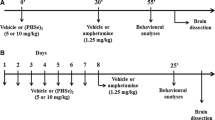Abstract
Ascorbic acid (50–200 mg/kg IP) activated gross behaviour and EEG of rats. The behavioural excitation induced by d-amphetamine (2.5 mg/kg SC) was significantly potentiated by ascorbic acid (100–200 mg/kg IP). Catalepsy induced by haloperidol (0.25 mg/kg IP) was attenuated by ascorbic acid (50–200 mg/kg IP) while pentobarbitone (20 mg/kg IP)-induced sleep in rats was dose-dependently antagonised by ascorbic acid (50–400 mg/kg IP). Ascorbic acid (50–400 mg/kg IP) desynchronized the EEG of the frontal cortex and optic cortex while the EMG activity was slightly enhanced in the rat. Ascorbic acid (100 mg/kg IP) potentiated d-amphetamine (2.5 mg/kg SC)-induced EEG desynchronization and EMG activation in the rat. These results indicate that ascorbic acid exerts stimulatory effects in rats. The results also suggest that dopaminergic mechanism may contribute indirectly or directly to the observed behavioural and EEG effects of ascorbic acid.
Similar content being viewed by others
References
Benton D (1981) The influence of large doses of vitamin C on psychological functioning. Psychopharmacology 75:98–99
Cocchi P, Silenzi M, Calabri G, Salvi G (1980) Antidepressant effect of vitamin C. Paediatrics 65 (4):862–863
Costall B, Hui SC, Naylor RJ (1978) Correlation between multitest and single test catalepsy assessment. Neuropharmacology 17:761–764
Janssen PA, Niemegeers CJ, Shellekens KH (1965) Is it possible to predict the clinical effects of neuroleptic drugs (major tranquillizers) from animal data? Neuroleptic activity spectra for rats. Arzneim Forsch 15:104–117
Kayaalp SO, Neff NH (1980) Differentiation by ascorbic acid of dopamine agonist and antagonist binding sites in the striatum. Life Sci 26 (22):1837–1841
Kuo CH, Hata F, Hoshida H, Yamatodani A, Wada H (1979) Effects of ascorbic acid on release of acetylcholine from synaptic vessicles prepared from different species of animals and release of noradrenaline from synaptic vessicles of rat brain. Life Sci 24:911–916
Lyhs L (1961) Influence of ascorbic acid deficiency on the functions of the CNS of the guinea-pigs. Monatsschr Viterinarmed 16:131–134
Lyhs L, Rvidiger W (1963) Functional decortication and content of ascorbic acid in the cerebrum of rats. Acta Biol Med Germanica 10:311–316
Pfeiffer CC, Goldstein L, Murphree HB, Nicols RC (1968) A critical survey of possible biochemical stimulants. In: Efron DH (ed). Psychopharmacology — a review of progress Dept of Health, Education and Welfare, Washington DC
Pitt B, Pollit N (1971) Ascorbic acid and chronic schizophrenia. Br J Psychiatry 118:227–228
Sjostrand ST (1970) Pharmacological properties of dehydroascorbic acid: Effects on the central and peripheral nervous system in experimental animals. Acta Physiol Scand Suppl 356:1
Slater G (1962) Adrenal ascorbic acid and plasma adrenocorticoid response to fasting in young rats. Endocrinology 70:18–23
Stolk JM, Rech RH (1970) Antagonism of d-amphetamine by alpha methyl paratyrosine. Behavioural evidence for the participation of catecholamine stores and synthesis in the amphetamine stimulant response. Neuropharmacology 9:249–263
Snyder SH, Greenberg D, Yamamura HI (1974) Antischizophrenic drugs. Affinity for muscarinic-cholinergic receptor site in the brain predicts extra-pyramidal effects. J Psychiatr Res 11:91–95
Tolbert LC, Thomas TN, Middaugh LD, Zem JW (1979) Effect of ascorbic acid on neurochemical, behavioural and physiological systems mediated by catecholamines. Life Sci 25:2189–2195
Wambebe C, Osuide G (1983) Influence of FLA-63 on pentobarbitone sleep in chicks and rats. Clin Exp Pharmacol Physiol 10:555–566
Author information
Authors and Affiliations
Rights and permissions
About this article
Cite this article
Wambebe, C., Sokomba, E. Some behavioural and EEG effects of ascorbic acid in rats. Psychopharmacologia 89, 167–170 (1986). https://doi.org/10.1007/BF00310622
Revised:
Issue Date:
DOI: https://doi.org/10.1007/BF00310622



